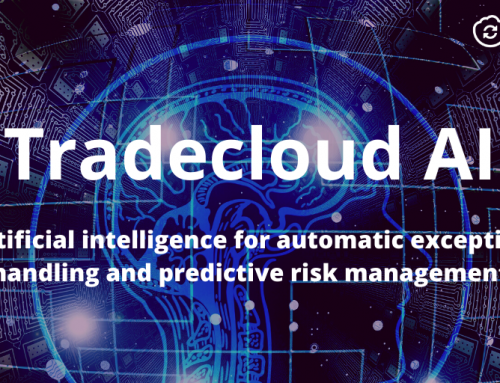Product development insights: AI-based Supply Chain Risk Indicator
In the complex world of supply chain management, unexpected challenges can often arise, leading to costly delays and logistical nightmares. To provide insights into this complex world, Tradecloud will focus on AI tools for Risk analysis & Purchase automation, as mentioned in the previous blog post.
To build customer confidence in AI-driven purchase decisions, our first step is implementing an AI risk indicator that conducts a proper risk analysis. This initial version predicts potential supply chain issues and enables companies to proactively address issues before they escalate. It achieves this by predicting exceptions for individual order lines based on historical data within the Tradecloud One platform.
The indicator will assist purchasers in estimating the risk of disruptions within their supply chain. However, the purchaser must still interpret whether this exception will indeed lead to a disruption, considering factors such as whether the order line contains a critical component or just a regular stock item with plenty of safety stock available.
Once the first version of the AI risk indicator goes live, user feedback will be collected to further enhance the indicator’s sophistication. Additional supply chain related data, such as MRP, stock level, and sales orders & forecast data for ERP systems, can be synced to the Tradecloud data lake. By leveraging vast troves of data, the AI indicator can accurately assess the probability of unforeseen expectations and indicate the severity of disruptions, empowering companies to stay one step ahead in their decision-making processes.
Furthermore, additional general supply chain data can be incorporated to enhance the indicator’s accuracy. This data includes traffic information, port congestions, and weather forecasts. Moreover, non-supply chain related data, such as political events, new legislations, and natural disasters, can also be integrated to provide a comprehensive risk assessment.
Additionally, proactive alerts can be sent to both purchasers and suppliers. These will alert our customers when the risk indicator expects an exception that may lead to a disruption, fostering a stronger relationship between both buyer and supplier.
The Proof of Concept
As described in the previous blogposts, AI will only succeed if it’s used for the right use case, based on the right data.
Although we had a vision, you never know for sure if it will work out the way you planned to.
As a result, we first set out to create a Proof of Concept in 2020. Together with Tilburg University and Delft University of Technology, we set out an Intership, focussed on implementing a Machine Learning or AI algorithm by ourselves, based on the data we had. At that time, Tradecloud One was only just launched and the amount of data we had available was very limited. Although it was rapidly growing, this could pose a real challenge for the internship.
We were lucky enough to find Arbnor Rama, an ambitious student who was eager to take on this challenge. Supervised by our Tech Lead, who graduated in AI several years earlier, Arbnor set out to investigate how to add value to the Tradecloud One platform by using AI/ML.
The following Machine Learning Algorithms were investigated:
- (Multiple) Linear Regression
- Logistic Regression
- K-Nearest Neighbors
- Decision Trees / Random Forests
- Neural Networks
- Evolutionary Algorithms (Genetic Algorithms and Genetic Programming)
From these algorithms, Neural Networks were found to be the most suitable for our product. This was mainly due to its broad applicability and because there are battle-tested libraries available such as PyTorch, ScikitLearn and Tensorflow, which would speed up the development process and would contribute to the extensibility and maintainability of an AI Risk Indicator.
After several months of implementation and running experiments, we were able to train a model on Tradecloud One data, using our own home-brewed Neural Network. During the experiments we saw that, indeed, the amount of data that was available in Tradecloud One was a little limited, but as we regularly ran experiments, we saw that the quality of the AI Risk Indicator improved.
Eventually this resulted in a precision (recall) of 71%. This was really not bad for a first attempt, taking into account the limited amount of data and development hours that were available.
The resulting Neural Network was still far from being production-ready, but the internship was a great success, as it showed us that we were using the right tools to tackle the right use case. While the predictions could still significantly be improved, it proved that as our data lake set would grow, we could make a viable product out of this. Although it required quite some additional development, this could add significant value to our platform for our customers.
Our MVP
Although our PoC showed that it was possible to implement an AI Risk Indicator that could add great value to the Tradecloud One platform, there were still a lot of improvements that had to be done before we could incorporate it into our platform.
Usability
In the PoC, predictions were done by manually executing the Neural Network, which was done by a developer. Instead, these predictions would have to be automated and made available to our Web Portal. This means that the Neural Network (model) would have to be incorporated into a microservice, which can expose an API that can be queried by the Web Portal when eg. an order detail page would be opened.
Security
Exposing the predictions through an API also means that proper authorization should be in place. Just like with all data in Tradecloud One, users can only read data that they are authorized for, meaning data that is relevant for only their company.
Scalability
The predictions were currently done in batches. Instead, predictions should be done on-the-fly or even event-based as orders are issued.
Especially if we are to incorporate these predictions into the workflows of our customers, this means that the implementation should be rewritten to an event-based approach, where predictions are done as soon as an issued order is sent to Tradecloud One. This will allow us to, for example, create a workflow task when an exception is expected, immediately notifying a user.
Maintainability
During the internship, we effectively had two developers with a Machine Learning background that would be able to maintain the implemented algorithm. In the long term, however, it’s not guaranteed that we have full-time ML developers. Hence, our MVP would have to be based on ML products that require less maintenance and in-depth knowledge of ML.
Our Implementation
Based on these requirements, we investigated several AI platforms and tools. We chose GCP’s Vertex AI as it would seamlessly integrate with our data lake and because it offered great flexibility in terms of data sources and ML algorithms.
As mentioned earlier, however, we would first need to migrate from our previous cloud provider to GCP. This was, to put it mildly, a non-trivial effort. Our infra team worked tirelessly on this migration and we’re proud to say that, since we have migrated, the stability of Tradecloud One has greatly increased, as well as the scalability and maintainability.
This did put our AI Risk Indicator development a bit on the back burner for some time, however. Nevertheless, once we started our implementation of the AI Risk Indicator based on Vertex AI, we got results pretty quick.
Moreover, as we progressed in our development and ran our first training on real data, we are able to get significantly better results compared to the PoC, with a recall and precision of 91%!
Check out our Knowledge Base for the most up-to-date information about our AI Risk Indicator model, as well as more information about how we safeguard the quality of the AI Risk Indicator predictions.
Future plans
We are very proud to announce that we have an operational AI Risk Indicator available on Tradecloud One. However, the AI Risk Indicator is currently still in a closed-beta, as we want to improve it in several ways, before rolling it out to all our customers. We want it to be battle-tested and we want it to seamlessly integrate with our customers’ way of working, so it will truly help our customers to focus on exceptions.
Below is a short overview of some of the improvements we plan to make. This overview is still tentative, as it is subject to customer feedback and compatibility with our Product Roadmap
Event-based predictions
As described in our previous blogpost, we want to make predictions event-based. The entire Tradecloud One platform is event-based, which means that every action of a customer and every message from our integrated ERP systems will asynchronously trigger a series of events, eventually resulting to an outcome that is visualized by our Web Portal, or sent back to an integrated ERP system of the related parties.
In the case of the AI Risk Indicator, this would mean that as soon as an issued order line is sent to Tradecloud One, a prediction will be done and stored for this order line.
The benefit is that other components, like workflow tasks, can reactively tap into such a prediction and for instance create a new task for the buyer or supplier.
An additional advantage, is that this is a scalable approach to persisting predictions, meaning that it would be possible to eg. filter order lines on their AI Risk Indicator prediction in the order line overview page.
Last but not least, this will enable us to include predictions in the activity stream of an order. Although we currently only evaluate predictions after an order line is issued, we may also want to re-evaluate predictions at a later stage, or predict other exceptions in the lifecycle of an order line. In this case, it is important to visualize at which point in time the AI Risk Indicator predicted an exception.
Evaluating predictions in an event-based way will ensure scalability and support enhanced incorporation of the AI Risk Indicator into our customers’ workflows.
Improve prediction quality
Although the quality of the AI Risk Indicator model is already pretty high, there is always room for improvement. We expect that we can achieve more accurate predictions by enriching our dataset with various other data types. Examples are: recent order history, recent user activity in the portal, but also including other data sources like news feeds related to Supply Chain events, latest commodity stock data, etc..
In fact, if a customer also uses Tradecloud One’s Shipment or Forecast module, such forecasts or shipment data may be very relevant for the order lines that are currently being issued.
There is one group of “features” in particular that we expect will contribute to this: time-based features. We think that the chance of an exception happening can vary over time. For instance: if a supplier usually responds within 24 hours, but still didn’t respond after 3 days, this may be a clear indicator that something is not right.
Configurability
Although we use our customer feedback to improve the usability and quality of the AI Risk Indicator over time, not every customer has the same needs. While one customer may rather get warned too often than too little, it may be the other way around for another customer.
By defining settings such as a Confidence Threshold for the AI Risk Indicator for your company, you can adjust it to your needs. This will improve the user experience, as it should mean that you will only be warned when you want to.
Expand predictions throughout the platform
We’ve currently only focussed on predicting whether a supplier will propose changes, or reject an order line. However there are way more situations in which you may want to know the probability of an exception happening:
- It may be that an order gets canceled, this could happen any time.
- After an order line is confirmed, it can happen that either the buyer or supplier will request to reopen the line, due to unforeseen events.
- If you use our Shipments module; you may want to know whether an exception will happen with a particular shipment.
- Or even better: if you use our Forecast module, it may even be possible to predict exceptions as soon as your forecasting system has predicted your company’s demand for next year.
Questions?
Are you wondering if we would be able to predict some other exception in your supply chain? Or do you wonder what Tradecloud One’s AI Risk Indicator could mean for your company?
Drop us an email at support@tradecloud.nl, and don’t forget to check out our Knowledge Base.



